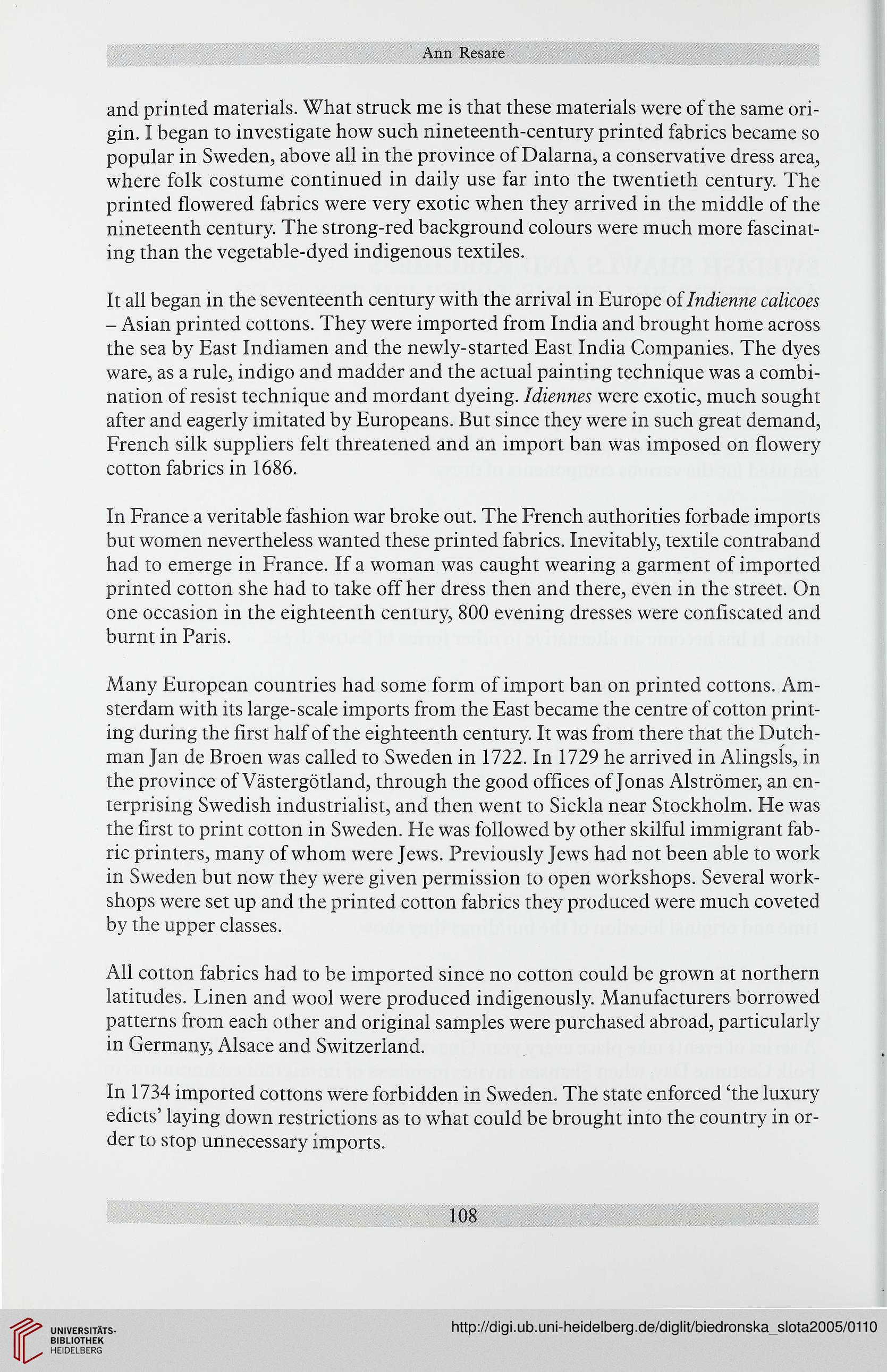Ann Resare
and printed materials. What struck me is that these materials were of the same ori-
gin. I began to investigate how such nineteenth-century printed fabrics became so
popular in Sweden, above all in the province of Dalarna, a conservative dress area,
where folk costume continued in daily use far into the twentieth century. The
printed flowered fabrics were very exotic when they arrived in the middle of the
nineteenth century. The strong-red background colours were much more fascinat-
ing than the vegetable-dyed indigenous textiles.
It all began in the seventeenth century with the arrival in Europę oilndienne calicoes
- Asian printed cottons. They were imported from India and brought home across
the sea by East Indiamen and the newly-started East India Companies. The dyes
ware, as a rule, indigo and madder and the actual painting techniąue was a combi-
nation of resist techniąue and mordant dyeing. Idiennes were exotic, much sought
after and eagerly imitated by Europeans. But sińce they were in such great demand,
French silk suppliers felt threatened and an import ban was imposed on flowery
cotton fabrics in 1686.
In France a veritable fashion war broke out. The French authorities forbade imports
but women nevertheless wanted these printed fabrics. Inevitably, textile contraband
had to emerge in France. If a woman was caught wearing a garment of imported
printed cotton she had to take off her dress then and there, even in the street. On
one occasion in the eighteenth century, 800 evening dresses were confiscated and
burnt in Paris.
Many European countries had some form of import ban on printed cottons. Am-
sterdam with its large-scalę imports from the East became the centrę of cotton print-
ing during the first half of the eighteenth century. It was from there that the Dutch-
man Jan de Broen was called to Sweden in 1722. In 1729 he arrived in Alingsls, in
the province of Vastergótland, through the good offices of Jonas Alstrómer, an en-
terprising Swedish industrialist, and then went to Siekła near Stockholm. He was
the first to print cotton in Sweden. He was followed by other skilful immigrant fab-
ric printers, many of whom were Jews. Previously Jews had not been able to work
in Sweden but now they were given permission to open workshops. Several work-
shops were set up and the printed cotton fabrics they produced were much coveted
by the upper classes.
All cotton fabrics had to be imported sińce no cotton could be grown at northern
latitudes. Linen and wool were produced indigenously. Manufacturers borrowed
patterns from each other and original samples were purchased abroad, particularly
in Germany, Alsace and Switzerland.
In 1734 imported cottons were forbidden in Sweden. The state enforced 'the luxury
edicts' laying down restrictions as to what could be brought into the country in or-
der to stop unnecessary imports.
108
and printed materials. What struck me is that these materials were of the same ori-
gin. I began to investigate how such nineteenth-century printed fabrics became so
popular in Sweden, above all in the province of Dalarna, a conservative dress area,
where folk costume continued in daily use far into the twentieth century. The
printed flowered fabrics were very exotic when they arrived in the middle of the
nineteenth century. The strong-red background colours were much more fascinat-
ing than the vegetable-dyed indigenous textiles.
It all began in the seventeenth century with the arrival in Europę oilndienne calicoes
- Asian printed cottons. They were imported from India and brought home across
the sea by East Indiamen and the newly-started East India Companies. The dyes
ware, as a rule, indigo and madder and the actual painting techniąue was a combi-
nation of resist techniąue and mordant dyeing. Idiennes were exotic, much sought
after and eagerly imitated by Europeans. But sińce they were in such great demand,
French silk suppliers felt threatened and an import ban was imposed on flowery
cotton fabrics in 1686.
In France a veritable fashion war broke out. The French authorities forbade imports
but women nevertheless wanted these printed fabrics. Inevitably, textile contraband
had to emerge in France. If a woman was caught wearing a garment of imported
printed cotton she had to take off her dress then and there, even in the street. On
one occasion in the eighteenth century, 800 evening dresses were confiscated and
burnt in Paris.
Many European countries had some form of import ban on printed cottons. Am-
sterdam with its large-scalę imports from the East became the centrę of cotton print-
ing during the first half of the eighteenth century. It was from there that the Dutch-
man Jan de Broen was called to Sweden in 1722. In 1729 he arrived in Alingsls, in
the province of Vastergótland, through the good offices of Jonas Alstrómer, an en-
terprising Swedish industrialist, and then went to Siekła near Stockholm. He was
the first to print cotton in Sweden. He was followed by other skilful immigrant fab-
ric printers, many of whom were Jews. Previously Jews had not been able to work
in Sweden but now they were given permission to open workshops. Several work-
shops were set up and the printed cotton fabrics they produced were much coveted
by the upper classes.
All cotton fabrics had to be imported sińce no cotton could be grown at northern
latitudes. Linen and wool were produced indigenously. Manufacturers borrowed
patterns from each other and original samples were purchased abroad, particularly
in Germany, Alsace and Switzerland.
In 1734 imported cottons were forbidden in Sweden. The state enforced 'the luxury
edicts' laying down restrictions as to what could be brought into the country in or-
der to stop unnecessary imports.
108





